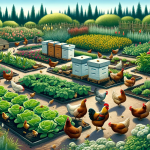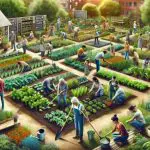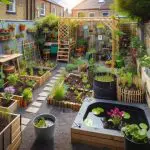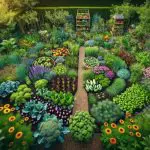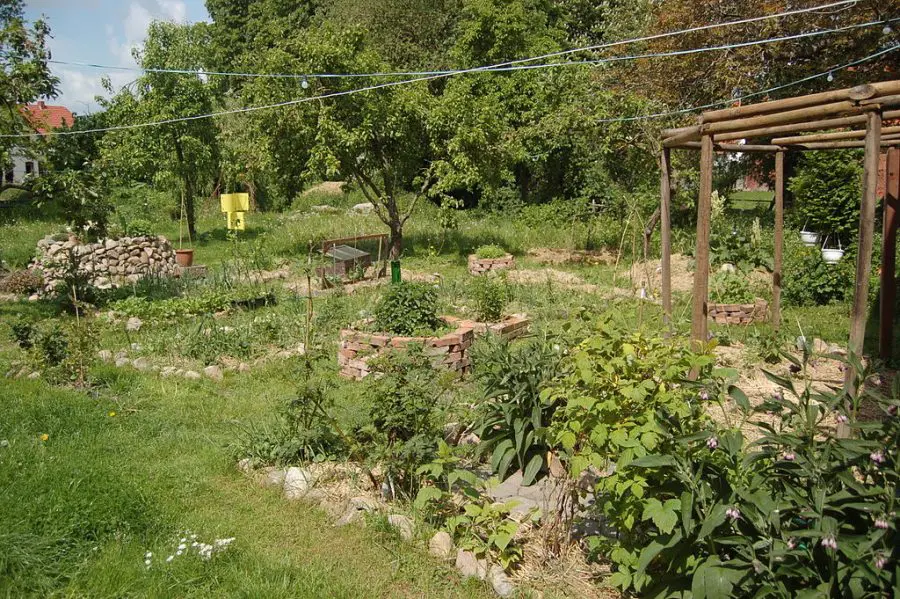
Ever wondered, what is permaculture gardening? Dive in to uncover its magic and how it’s changing our bond with Mother Earth.
Have you ever stumbled upon the term and thought, what is permaculture gardening? It’s more than just a gardening trend; it’s a philosophy, a way of life, and a promise to our planet.
Imagine harmonizing with nature, letting it guide your green thumb, and creating a sustainable oasis right in your backyard. Intrigued?
Let’s dig deeper and unearth the wonders of permaculture gardening together!
What is Permaculture Gardening?
Ever wondered about a gardening approach that’s more than just planting and harvesting?
Enter permaculture gardening. It’s a blend of permanent agriculture and conscious design, aiming to create sustainable and self-sufficient ecosystems.
From home gardens to vast landscapes, it’s about meeting human needs while working harmoniously with nature.
In this article, we’ll explore its roots, principles, and how you can take the first step towards creating your own food forest.
Definition of permaculture gardening
The big question on everyone’s mind: What exactly is permaculture gardening?
At its core, permaculture gardening is a holistic approach to gardening that emphasizes the creation of sustainable and self-sufficient ecosystems.
Think of it as a dance with nature, where every step is in tune with the environment.
Instead of imposing our will on the land, we work with it, understanding its rhythms, and using its strengths to our advantage.
It’s not just about growing plants; it’s about cultivating a relationship with the earth, ensuring that both the land and its inhabitants thrive together.
Brief history and origin
Now, let’s take a step back in time. The concept of permaculture isn’t as modern as you might think.
The term permaculture was coined in the 1970s by two Australians, Bill Mollison and David Holmgren.
It’s a fusion of permanent and agriculture, but it’s so much more than that.
Mollison and Holmgren were visionaries who saw the damage being done to our planet and believed there had to be a better way.
Drawing inspiration from indigenous farming practices and natural ecosystems, they developed a set of principles that aimed to create harmonious, sustainable, and resilient systems.
Over the years, their ideas spread like wildfire, inspiring countless individuals to look at gardening and farming in a whole new light.
And just like that, the permaculture movement was born!
Core Principles of Permaculture
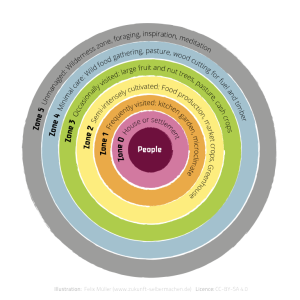
Alright, now that we’ve dipped our toes into the world of permaculture gardening, let’s dive a bit deeper, shall we?
At the heart of this incredible approach are some core principles that guide every shovel of dirt and every planted seed.
These aren’t just random rules; they’re the backbone of the entire permaculture philosophy.
So, grab your gardening gloves and your curiosity, and let’s explore the guiding stars of permaculture together!
Diving into permaculture is like opening a treasure chest of nature’s best practices.
At its heart are ethics and design principles that prioritize the Earth, people, and sharing resources.
It’s about understanding natural systems, promoting sustainable agriculture, and ensuring every living being, from beneficial insects to tall trees, thrives.
Permaculture is an approach to land management and settlement design that adopts arrangements observed in flourishing natural ecosystems. It includes a set of design principles derived using whole-systems thinking. From Wikipedia
Ethics and Design Principles
Let’s kick things off with the very foundation of permaculture: its ethics and design principles.
At its core, permaculture is guided by three main ethics: care for the earth, care for people, and fair share. Sounds simple, right?
But these ethics are profound. They urge us to respect our planet, look out for each other, and share resources in a way that ensures everyone gets a slice of the pie.
Building on these ethics are the design principles, which are like a roadmap for creating sustainable systems.
From observing and interacting with nature to using renewable resources and producing no waste, these principles are the golden rules every permaculture gardener swears by.
Working with Nature, Not Against It
Now, here’s a game-changer: Instead of trying to dominate nature, what if we worked hand in hand with it?
That’s the essence of this principle. It’s about recognizing that nature, with its intricate web of life, has been doing its thing for eons.
And guess what? It’s pretty darn good at it! So, instead of reinventing the wheel, permaculture teaches us to observe, learn, and then emulate nature’s patterns and processes.
It’s like having Mother Nature herself as your gardening mentor!
Sustainable Food Sources and Ecosystem Creation
Last but certainly not least, let’s chat about food and ecosystems.
One of the most exciting aspects of permaculture is its focus on creating gardens that not only feed our bellies but also nourish our souls and the environment.
By designing gardens that mimic natural ecosystems, we can produce an abundance of food while also creating habitats for wildlife, improving soil health, and conserving water. It’s a win-win-win!
Imagine a garden where every plant has a purpose, where there’s a beautiful balance between giving and taking, and where the buzz of bees and the rustle of leaves are the soundtrack to your day.
That’s the magic of permaculture in action!
Elements and Practices in Permaculture
Okay, so we’ve chatted about the core principles, but how do we bring them to life in our gardens?
That’s where the fascinating elements and practices of permaculture come into play.
Think of these as the tools in our gardening toolkit, each with its unique purpose and magic.
From innovative watering techniques to the art of companion planting, these practices are the hands-on ways we make our gardens thrive.
Ready to roll up your sleeves and dive into the nitty-gritty of permaculture practices? Let’s get to it!
From sheet mulching to keyhole gardens, permaculture offers a plethora of techniques to make any garden flourish.
Whether you’re into organic gardening or keen on exploring vertical gardening techniques, there’s something for everyone.
And the best part? These methods often require less effort and result in productive ecosystems that are low maintenance.
Hydroponics
Let’s start with a splash, Hydroponics! Ever imagined growing plants without soil? Hydroponics makes it possible.
It’s a method where plants are grown in a nutrient-rich water solution, allowing them to absorb minerals and vitamins directly.
Picture this: vibrant lettuce, juicy tomatoes, and fresh herbs, all thriving without a speck of dirt. It’s efficient, space-saving, and perfect for urban gardeners with limited space.
Plus, it’s like giving your plants a VIP pass to all the nutrients they crave!
Ecological Gardening
Next up, we have Ecological Gardening, and it’s all about embracing nature’s wisdom.
This approach encourages us to create gardens that mimic natural ecosystems.
It’s not just about planting; it’s about understanding the relationships between plants, insects, and the environment.
By fostering these connections, we create gardens that are resilient, diverse, and teeming with life.
It’s like hosting a party where every guest, from the tiniest insect to the tallest tree, plays a vital role.
Organic Farming
Organic Farming, is the buzzword we all know and love. But it’s more than just a trend; it’s a commitment to growing food without synthetic pesticides, herbicides, or fertilizers.
It’s about nurturing the soil, promoting biodiversity, and ensuring that our food is as natural as Mother Nature intended.
And the best part? Every bite is not only delicious but also free from harmful chemicals.
Biodynamic Farming
Now, let’s delve into the mystical world of Biodynamic Farming. Rooted in ancient wisdom and cosmic rhythms, this method views the farm as a living organism.
It goes beyond organic practices by integrating lunar cycles, planetary alignments, and special preparations made from herbs and minerals.
The result? A harmonious farm where plants, animals, and humans thrive in sync with the universe.
Agroforestry
Imagine a forest where every tree, shrub, and herb is edible or useful. Welcome to Agroforestry!
This practice blends agriculture and forestry, creating systems where trees and crops grow side by side.
It’s a win-win: trees provide shade, reduce erosion, and enhance soil fertility, while crops benefit from improved conditions. Plus, it’s a haven for wildlife!
Bio-intensive Farming
Ready to supercharge your garden? Enter Bio-intensive Farming.
This method focuses on maximizing yields from small plots through deep soil preparation, close planting, and crop rotation.
The goal? To produce more with less land, water, and energy. It’s all about efficiency, making every inch of your garden work its hardest.
Zero-tillage Farming
Last but not least, let’s talk about Zero-tillage Farming. Say goodbye to the traditional plow and hello to a method that leaves the soil undisturbed.
By not tilling, we preserve soil structure, reduce erosion, and enhance water retention.
It’s a gentler approach, letting the soil’s natural communities flourish while making farming more sustainable.
Whew! That’s quite the journey through the diverse practices of permaculture. Each method offers its unique magic, showing us the many ways we can dance with nature in our gardens.
Advantages of Living in a Permaculture Community
Ever daydreamed about living in a place where everyone’s on the same eco-friendly page?
Where gardens flourish, neighbors share fresh produce, and sustainability isn’t just a buzzword but a way of life?
Welcome to the world of permaculture communities! These aren’t just any neighborhoods; they’re hubs of green innovation and collaboration.
Let’s dive in and discover the perks of being part of such a vibrant, earth-loving community!
Living in a permaculture community is like being part of a vibrant, green tapestry.
Here, every element, from edible plants to rain barrels, plays a crucial role.
It’s a place where organic matter enriches the soil, native plants thrive, and clean water is a shared treasure.
Plus, with community gardens, and shared permaculture courses, learning and growth are always on the horizon.
Protection of Natural Resources
Imagine a place where every drop of water, every gust of wind, and every ray of sunshine is cherished.
In a permaculture community, the protection of natural resources isn’t just a goal; it’s a way of life.
Residents are keenly aware of the value of Mother Earth’s gifts and go to great lengths to conserve and utilize them wisely.
Rainwater harvesting, composting, and recycling become second nature, ensuring that the community treads lightly on the planet.
Less Work and Energy Consumption
Now, here’s a fun fact: living in harmony with nature can actually mean less work for us!
By designing systems that mimic natural processes, a lot of the heavy lifting is done by nature itself.
Think self-watering garden beds, natural pest control, and passive solar heating.
Plus, with shared community responsibilities, tasks like gardening or maintenance become collective efforts, making them more efficient and enjoyable.
Promotion of Biodiversity
A walk through a permaculture community is like a mini safari.
You’ll find a rich tapestry of plants, insects, birds, and sometimes even small mammals. This isn’t by accident.
The community’s design encourages biodiversity, creating habitats for various species.
It’s a win-win: the wildlife gets a safe haven, and residents enjoy a vibrant, balanced ecosystem right at their doorstep.
Organic Crop Production
Forget those supermarket veggies; in a permaculture community, fresh, organic produce is just a stone’s throw away.
Gardens brim with a variety of crops, all grown without harmful chemicals.
And the best part? The taste! There’s nothing quite like biting into a tomato or a strawberry that’s been nurtured with love and natural care.
Boosted Health Benefits
Living in a permaculture community isn’t just good for the planet; it’s fantastic for our health too.
With access to fresh air, organic food, and plenty of green spaces for exercise, residents often find themselves feeling more energetic and vibrant.
Plus, the sense of community and shared purpose can do wonders for mental well-being. It’s holistic health at its best!
Efficient Use of Space
Space is a precious commodity, and in a permaculture community, every inch counts.
Through clever design and planning, spaces are optimized for multiple uses.
A rooftop might double up as a garden, a courtyard could serve as a communal gathering spot, and vertical gardens might adorn walls.
It’s all about making the most of what’s available, ensuring that both people and nature have room to thrive.
So, there you have it! Living in a permaculture community is more than just a green choice; it’s a lifestyle that offers countless benefits, both for us and for our beautiful planet.
Challenges and Disadvantages of Permaculture
While the world of permaculture paints a pretty picture of green gardens and sustainable living, it’s not all sunshine and rainbows.
Like any approach, permaculture comes with its own set of challenges and hiccups. But hey, that’s what makes the journey interesting, right?
Let’s pull back the curtain and take a candid look at some of the hurdles one might face while diving into permaculture.
It’s all part of the growth process, after all!
While permaculture offers a holistic approach to gardening, it’s not without challenges.
For instance, the design process requires a deep understanding of the land, and sometimes, dealing with invasive plants can be a task.
But with the right resources, like a permaculture design course, and a good design mindset, these hurdles can be overcome.
Time Commitment
Let’s face it, diving into permaculture isn’t a weekend hobby; it’s a commitment.
While nature does a lot of the work, setting up a permaculture system can be time-consuming.
There’s research to be done, designs to draft, and soil to prep. And once everything’s up and running?
Well, gardens need tending, compost needs turning, and rainwater systems need checking.
It’s a labor of love, but for those new to the game, the time investment can be a tad overwhelming.
Mental Shifts and Lifestyle Changes
Switching to permaculture isn’t just about changing how you garden; it’s about changing how you think.
It requires a mental shift from the fast-paced, consumer-driven world to a more mindful, sustainable mindset.
This might mean re-evaluating priorities, rethinking shopping habits, or even changing daily routines.
It’s a journey of self-discovery, and while it’s incredibly rewarding, it can also be a rollercoaster of emotions and adjustments.
Wealth Creation and Maintenance
Now, onto the practical stuff. While permaculture can save money in the long run (hello, home-grown veggies!), the initial setup can be a bit pricey.
Quality soil, seeds, tools, and sometimes even land can put a dent in the wallet.
And while the dream is to create self-sustaining systems, maintenance can sometimes require financial inputs.
It’s a balance between investing for the future and managing present expenses.
Difficulty in Accessing Goods and Services
Living the permaculture dream might mean residing in more remote or rural areas where the land is abundant but services? Not so much.
This can pose challenges in accessing certain goods, technologies, or even basic amenities.
Need a special tool or a rare seed variety? It might not be as easy as popping down to the local store.
It’s about being resourceful and sometimes getting creative with solutions.
Perception as Outside Mainstream Life
Lastly, there’s the perception factor. While the green movement is gaining traction, permaculture enthusiasts can sometimes be viewed as outliers or even rebels.
Friends or family might raise an eyebrow at composting practices or chuckle at rainwater harvesting systems.
It’s a path less traveled, and while the community is tight-knit and supportive, it can sometimes feel like swimming against the current in the broader societal stream.
But hey, every approach has its challenges, right? And often, it’s these very challenges that make the journey so enriching and the successes so sweet.
After all, it’s about growing not just plants, but as individuals and communities.
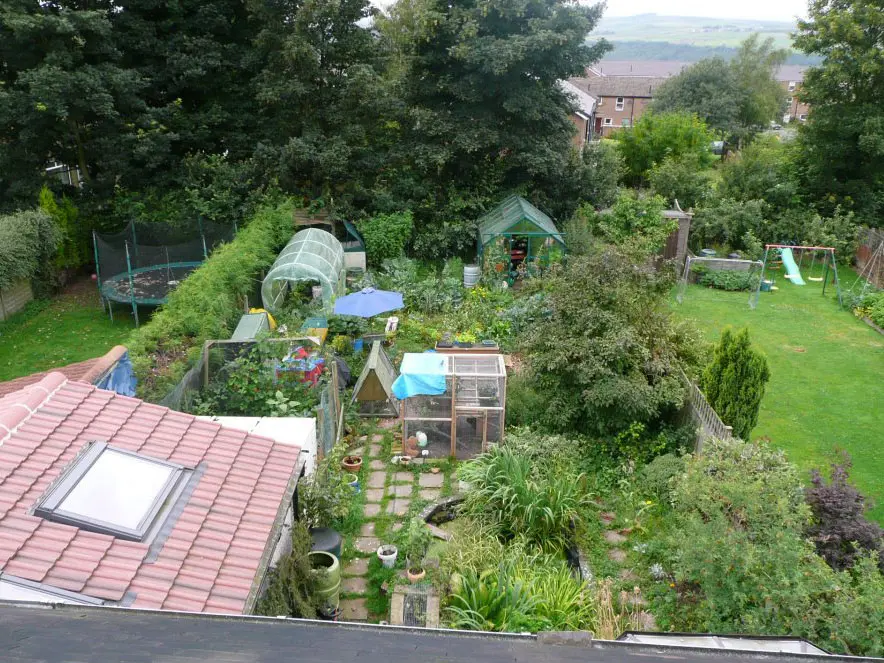
City slickers, this one’s for you! Who said permaculture is reserved for sprawling farms and vast meadows?
The concrete jungles we call cities are brimming with potential for green transformation.
Imagine rooftop gardens, vertical green walls, and community plots nestled between skyscrapers.
Permaculture in urban landscapes is not just possible; it’s a thriving movement.
Ready to discover how nature and city life can harmoniously coexist? Let’s navigate this urban green adventure together!
Who said cities can’t be green? With permaculture, urban landscapes transform into thriving ecosystems.
Think food gardens on balconies, vertical gardening techniques on walls, and rain barrels on terraces.
Even in a small area, with the right techniques, you can create a slice of nature in your daily life.
Waste and Water Management
City living often comes with its fair share of waste, doesn’t it? But here’s the cool part: in an urban permaculture setting, waste isn’t just discarded; it’s transformed.
Think composting systems turning kitchen scraps into gold for plants or rainwater harvesting setups catching every precious drop from those sudden downpours. It’s all about viewing waste as a resource.
And water? In the hustle and bustle of city life, efficient water management becomes crucial.
From greywater systems to drought-resistant plant choices, urban permaculture offers innovative solutions to make every drop count.
Local, Eco-friendly, and Healthy Food Production
Ever dreamt of plucking fresh tomatoes from your balcony or snipping herbs from a window box?
Urban permaculture makes it a reality. With a bit of creativity, even the tiniest spaces can become food-producing powerhouses.
Community gardens sprout in vacant lots, turning once-forgotten spaces into vibrant hubs of activity.
And the benefits? Fresh, local produce right at your doorstep, the reduced carbon footprint from transportation, and the unbeatable satisfaction of eating something you’ve grown yourself.
It’s a taste of the countryside, right in the heart of the city.
Ecological Living Systems
Now, let’s talk habitats. Cities aren’t just home to humans; they’re teeming with life. Birds, insects, and even the occasional urban fox.
Urban permaculture embraces this biodiversity, creating ecological living systems that benefit both humans and wildlife.
Green roofs offer sanctuary to birds, pollinator-friendly plants buzz with bees and natural pest control methods ensure a balance in the ecosystem.
It’s about creating a slice of nature amidst the concrete, ensuring that cities remain vibrant, diverse, and full of life.
After all, isn’t it magical to hear birdsong amidst the morning traffic or spot a butterfly fluttering by your window?
Permaculture FAQs
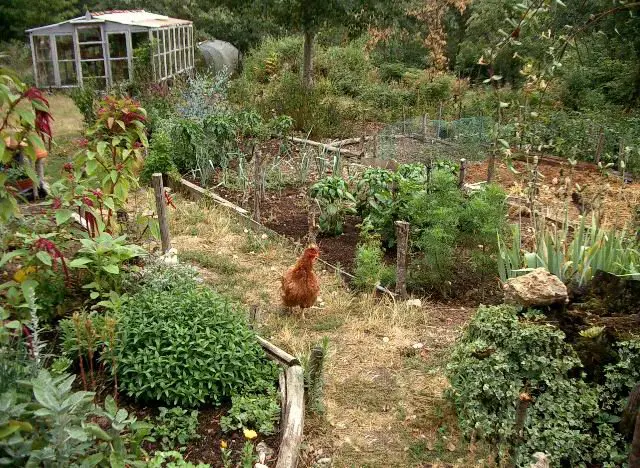
Alright, let’s hit the pause button for a moment. With all this talk about permaculture, I bet a few questions are bubbling up in your mind. You’re not alone!
Over the years, certain queries pop up time and time again from budding green thumbs and curious minds alike.
So, let’s dive into some of the most frequently asked questions about permaculture.
Whether you’re a seasoned gardener or just starting out, there’s always something new to learn.
From understanding the essence of permanent culture to exploring sustainable design science, our FAQ section delves deep into the world of permaculture.
Whether you’re curious about non-material needs or the intricacies of an ecological design system, we’ve got you covered.
Ready for some enlightening answers? Let’s jump in!
Q: How does permaculture differ from traditional farming?
A: Permaculture and traditional farming differ mainly in their approach and philosophy.
While traditional farming often focuses on single crops (monoculture) and might employ chemical fertilizers or pesticides, permaculture emphasizes creating a balanced ecosystem.
It’s about working with nature, not against it. Permaculture integrates plants, animals, and humans into a self-sustaining system, often avoiding synthetic inputs and prioritizing biodiversity and sustainability.
Q: Can permaculture be applied in urban settings?
A: Absolutely! Permaculture isn’t just for sprawling rural areas.
In urban settings, permaculture can be applied through practices like rooftop gardens, vertical farming, rainwater harvesting, and community gardens.
Even in limited spaces, permaculture principles can guide urban dwellers to utilize every nook and cranny efficiently, turning concrete jungles into green oases.
Q: What are the initial steps to start a permaculture garden?
A: Starting a permaculture garden is an exciting journey! Here are some initial steps:
• Observe and Research: Spend time observing your space. Understand the sunlight patterns, soil type, and local climate.
• Plan and Design: Based on your observations, create a design that mimics natural ecosystems. Consider elements like water sources, plant varieties, and wildlife habitats.
• Start Small: Begin with a small plot or area. This allows you to learn and adapt without feeling overwhelmed.
• Implement Sustainable Practices: Think composting, mulching, and natural pest control.
• Learn and Adapt: Attend workshops, read books, or join local permaculture groups to continue learning and refining your garden.
Remember, permaculture is a continuous journey of learning and growing with nature. Enjoy every moment of it!
Permaculture Gardening Conclusion
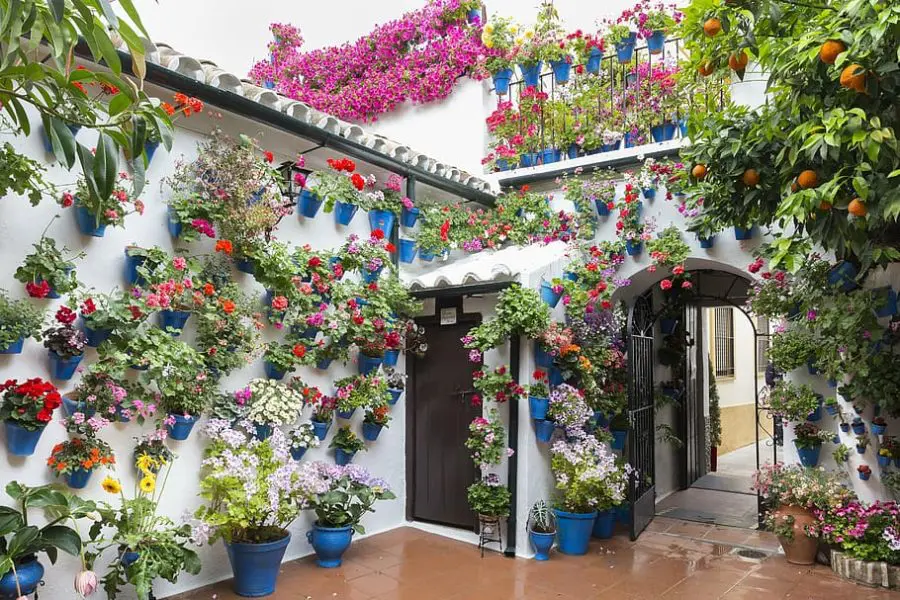
Well, what a green-filled journey we’ve been on together! From the very essence of permaculture gardening to its application in the heart of bustling cities, we’ve dug deep into this beautiful world.
But as we wrap things up, let’s take a moment to reflect on the bigger picture and the promising future of sustainable living.
Ready to tie it all together and look ahead? Let’s wrap this up with a neat little bow!
As we wrap up, remember that permaculture is more than just a gardening method; it’s a philosophy, a way of life.
It’s about understanding the natural world, harnessing natural materials, and creating regenerative systems.
So, whether you have a sprawling garden or a small area in the city, there’s always a way to embrace permaculture. Ready to take the leap?
The future of permaculture gardening
As we stand on the brink of a new era, the future of permaculture gardening shines brighter than ever.
With increasing awareness about climate change and the need for sustainable practices, more and more people are turning to permaculture as a solution.
It’s not just a gardening trend; it’s evolving into a global movement.
Schools are introducing permaculture in their curriculums, cities are adopting green infrastructure, and communities worldwide are coming together to share knowledge and resources.
As technology advances, we can expect even more innovative tools and methods to enhance permaculture practices.
The dream? A world where every garden, whether in a sprawling countryside or a compact urban setting, thrives on the principles of harmony, sustainability, and respect for nature.
Encouragement for sustainable living
If there’s one takeaway from our deep dive into permaculture, it’s this: sustainable living is not just possible; it’s essential.
And the best part? Every single one of us can play a role. Whether it’s planting a tree, starting a compost pile, or simply choosing to buy local produce, every small action counts.
Sustainable living isn’t about making huge sacrifices; it’s about making informed choices.
It’s about understanding the impact of our actions on the environment and striving to leave a positive mark.
So, as we conclude, here’s a little nudge: Embrace the permaculture spirit. Let it guide your choices, inspire your actions, and fuel your passion for a greener, brighter future.
After all, the journey to a sustainable world starts with a single step, and there’s no better time to take it than now!






